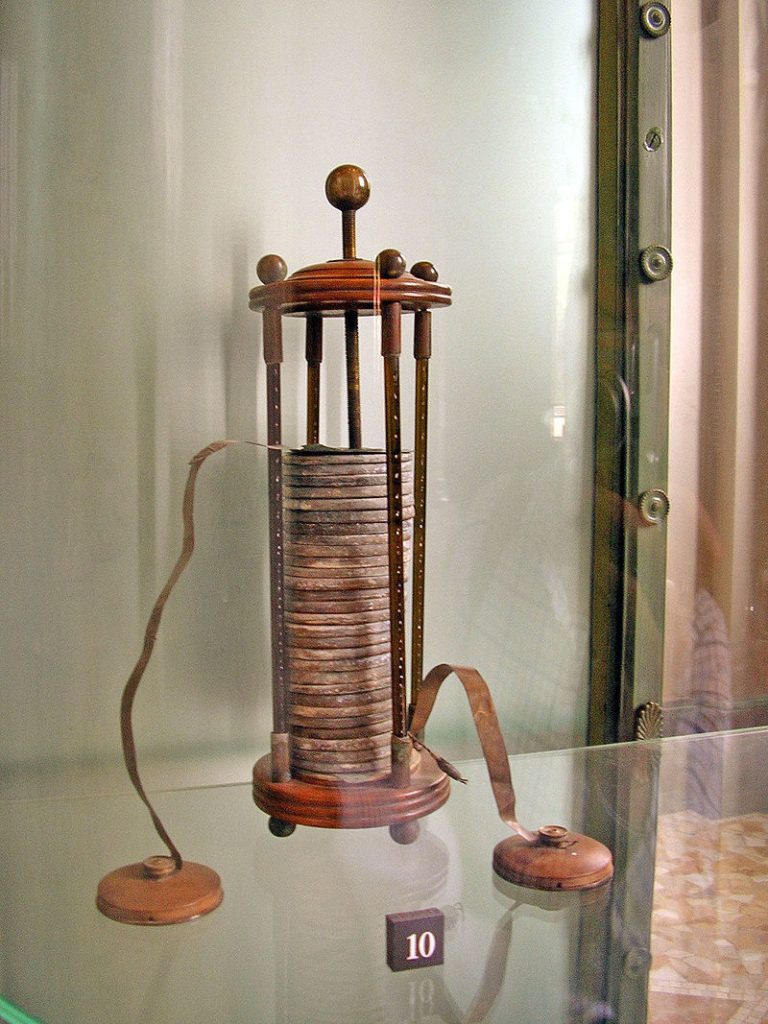Can you imagine a day without a battery? All our devices from smartphones to pacemakers use the power of batteries to harness electricity. These devices play a pivotal role in our society and it is important to give credit where credit is due. You can thank the great Italian scientist Alessandro Volta for his discovery of the first ever battery coined the voltaic pile. If his name sounds a bit familiar it is because the volt (unit for electric potential) is named after him.

Alessandro Volta was born to an aristocratic family in Como, Italy on February 18th, 1745.1 Volta excelled in math and science at a very young age. Even as a school boy he showed a keen interest in electricity. In the eighteenth century, the phenomenon of electricity was an intellectual curiosity, and not much was known about its properties. Volta excelled in school, and in 1774 he became a professor of physics at the Royal School of Como.2 During his time as professor, his interest in electricity remained a focus of his work. He created the electrophorus, which was a device used to generate static electricity.
Volta never set out to invent the battery. His experiments on electricity were in response to the claims of a scientist and friend of his, who claimed to have found electricity in animals.3 This scientist was Luigi Galvani, a professor of anatomy at the University of Bologna. One day as Galvani was performing an experiment on frogs, he began to cut the legs so that they would be exposed. When he touched his steel scalpel with a brass hook holding the frog’s legs in place, he saw the legs twitch. Galvani was convinced that what was going on was the presence of animal electricity. Galvani thought the muscles of the frog stored its life force. When Volta learned about Galvani’s discovery of animal electricity, he went right away to try to replicate Galvani’s experiment. Volta wanted to see for his own eyes what Galvani had published to the scientific community about his new discovery. After completing the experiment dozens of times, Volta disagreed with Galvani. Volta believed that the movement of the frog legs were because of the electric stimulation that was provided by the steel scalpel and the brass hook.4 Volta concluded that the frog’s legs were merely a vessel for the electric stimulation.

Once Volta recreated Galvani’s experiment, he knew the key to producing electricity was by using two metals that were not the same and not the actual frog legs themselves. The frog legs could not produce any sort of electricity. The reason the frog legs would move was because of the charge which was sent through the frog legs and into the nerves inside the legs which in turn resulted in a twitch. This was an indication that electricity was present. Volta recreated the experiment but would later conclude the frog legs were not the only electricity indicators but so were other materials such as moist cards of brine, or cardboard soaked in salt water. This was when Galvani concluded that the electric charge came from the rods of metal themselves and had nothing to do with frog legs. For the first experiment he used five cups with brine or salt water in them. Then, by adding pieces of silver and zinc, he attached the cups by metal strips where he placed them into the cups of brine. He would then put one finger at each end of the cups to feel the slight electric shock. Impressed with his work, he wanted to see if he could recreate his experiment, but without all the brine water. He then created a circuit consisting of copper and zinc discs that were separated by a cardboard soaked in brine. Just by adding more copper, cardboard soaked in brine, and zinc, Volta was able to adjust the amount of electricity that was being produced by the circuit. This became the voltaic pile, the first battery with a reliable source of electricity. Once Volta realized what he had done, he was able to refute the idea Galvani proposed about animal electricity.

Volta published his experiment and findings to the scientific community and later was honored for his invention of the voltaic pile. Today it is now almost impossible to not be in constant contact with a battery. You can thank Alessandro Volta for his discovery of the battery, which became a template for our modern dry-cell batteries. We might also thank Luigi Galvani for his role in stimulating Volta’s experiments, and maybe even thank the many nameless frogs for their contributions.
- Oliver J. Thatcher, The Library of Original Sources (New York, Chicago: University Research Extension, 1907), 395. ↵
- Encyclopedia of World Biography, 2004, s.v. “Alessandro Volta,” by Paula K. Byers. ↵
- Joost Mertens, “Shocks and Sparks: The Voltaic Pile as a Demonstration Device,” The History of Science Society 89, no. 2 (June 1998): 303. ↵
- Giuliano Pancaldi, Volta: Science and Culture in the Age of Enlightenment (Princeton University Press, May 1, 2005), 110. ↵



51 comments
Kenneth Gilley
It is amazing to think that the discovery of batteries can be traced back to the humble frog. Given what we know about electricity now, it is curious that Luigi Galvani thought that thought that the frog’s legs stored their own sort of electricity. Alessandro Volta probably had no idea what would eventually become of his discoveries: now we are almost always using batteries. This was a very interesting article!
Sabrina Doyon
The poor frog! His legs were still twitching from the electricity! It is really interesting that the way the common battery was originally found was through mutilating a frog to determine if it has conductive properties. I also got to make one of the brine copper-zinc batteries in my chemistry class. It was really interesting learning the science behind how batteries work. And now I know the story too!
Antonio Coffee
The title for this video was really captivating and it is a great segway to lead as to what the rest of the article goes into. It is amazing how a small disagreement between colleagues lead to the creation of the battery. Frogs would not have been my guess as to where the discovery of electric conduction that lead to the battery came from. It is small accidents that can cause the greatest discoveries sometimes and this is a great example.
Leonardo Gallegos
Interesting article! It is astonishing to think how far science and technology have evolved over time. It makes me excited to think about the possibilities that may present in the future, certainly things that in today’s world may very much seem nearly impossible to create. Volta’s story is interesting because it also emphasizes the importance of following your dreams and passions and it shows the incredible results in simply doing so.
Maggie Amador
It’s amazing how the greatest creations can be the ones no one expected or the ones sparked from odd origins. Volta was undoubtedly a genius and it is crazy how he was able to create the voltaic pile. I never before considered the origins of a simple creation that I use in my day to day life, but the idea that electric frog legs led to the invention of the battery is an interesting thing to think about. Great article!
Richard Morales
This article was very interesting. The curiosity of Volta and his fellow scientists is amazing. It was kind of humorous to read about the experiment after they believed they found electricity in animals. I am thankful that he did complete his experiments and inadvertently invented the battery. It is amazing how such vital things can be conceived by coincidence. We must thank great minds like Volta for the modern technology we use today, and we must also thank the frogs.
Michael Hinojosa
I’m going to be honest, out of all the things that could’ve helped contribute to the creation of the battery I was not expecting frogs to be one of them! I think it’s cool how he handled his studies and innovations that helped contribute to the creation of the battery and the fact that he chose frogs of all things simply because he believed that they stored electricity within their tiny little amphibious bodies!
Alexander Manibusan
Yes, we must give credit to the frogs! This article was very humorous and very interesting to read. Didn’t Galvani also make a battery? Because I recall there being something called a galvanic cell. Though I may not have the same obsession as Volta, electricity is pretty fascinating. And in this day and age, we totally depend on it and take it for granted. I’m very grateful that scientist like Volta were the predecessors that gave us the world we know now.
Robert Rodriguez
The title of the article instantly caught my attention, my first reaction was “Whaaaat?” ahaha. its amazing to see where science once was in history, especially at a time where they believed electricity could be found in frogs legs… I’ve heard of many scientific discoveries being discovered by accident such as this one, its always interesting to see their original intent and how they end up turning out for the better. I never thought Id thank frogs for an invention that basically changed the world.
Maria Esquivel
Very interesting article. I never knew how the battery came about, and it was so interesting to find out how Alessandro Volt invented it. It was also really interesting how Alessandro was inspired by Luigi Galvani and his experiment on frogs. With this inspiration, he conducted his own experiment and the ‘voltaic pile’ was born. Something he did not expect to invent, but now this device is used every single day. How awesome!